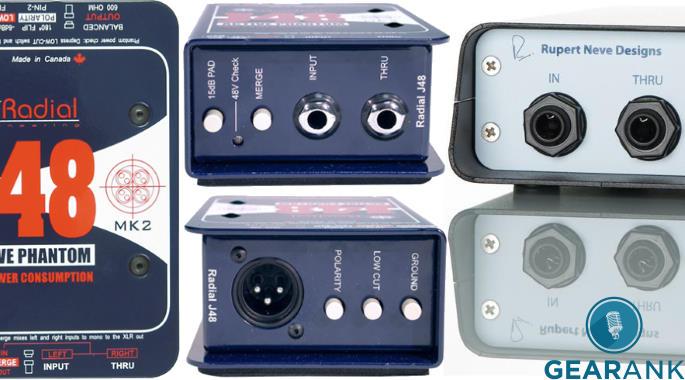

Radial reamp jcr vs prormp manual#
Don't know where to point you, other than the manual or tech support.īTW, my ProRMP XLR connector could have a tighter fit. It's likely to have an operating level setting or some kind of output level adjustment. The Quantum specifications show a max output level of +18dBu. I'm not familiar with the Quantum, but as mentioned in the above post(s), definitely make sure the output operating level is set to +4dB. I have the ProRMP's 'output level' control backed-off from the max and set around noon. Probably could run the average level even lower.

The peaks are usually in the single digits. I have used a wide range of DI'd average levels in StudioOne - with signals in the "-" high teens, anywhere from -20dB to -15dB. Here are some thoughts:ĭefinitely good that you have balanced out from the Quantum to the ProRMP. I can usually match the guitar vs ProRMP levels at the amp really closely. I also have a Radial ProRMP, and have not experienced the same issues with low levels. Is the Quantum set for those output levels"? Where can I verify that level is set correctly? Now when you say that "The RMP is expecting +4 dBu as well coming towards it. PresonusAaron wroteI am currently using a balance TRS to XLR to the Reamp box. Even with a balanced lead if the Studio One-reamp level is way down maybe you are tracking too quietly and need to record louder. An unbalanced lead may be messing up the RMP input impedance as well. Its better than the crappy Radial ProRMP, which is too quiet, and costs less. After adjusting the control on the RMP both levels should be very close.Ī proper balanced lead from Quantum to the RMP will add 6 dB of signal level compared to an unbalanced connection. IMO the Palmer Daccapo is great and quite affordable. Then connect the re-amp pedal from Studio One and play the guitar track you have recorded. plug your guitar directly into the amp and set for a modest level or basic overall level. I go direct into audio interface (MOTU M2) to record dry signal of my guitars. I assume it is already.Ĭheck as per the instructions as well. My purpose of re-amping is to try various settings & combinations of amp eq and effects pedals without having to play the same parts over and over again every time I change the setup. Is the Quantum set for those output levels.

The RMP is expecting +4 dBu as well coming towards it. I would be using a TRS balanced lead from either the main out or one of the other line outs from the Quantum to an XLR male connector to go into the preamp pedal. It is transformer isolated and provides the right input impedance to match the output impedance from the Quantum. The Radial ProRMP is a passive Reamper that lets you take a pre-recorded. It takes the high level line level signal from your interface and drops it down to guitar levels suitable for an amp. The Radial Engineering Reamp JCR is a passive Reamper that allows you to. The Radial ProRMP is a passive re amping box. I sometimes feel the plugins in DAWs are a bit sterile, or ludicrously expensive but I've spent hundreds of pounds on guitar pedals that have incredible sounds, so now I'm able to use them to achieve the sounds I want.The DI is not actually required in the re-amping process. It's also allowed me to experiment with using my guitar pedals as vocal effects units as well which is opening a world of possibilities. The Radial X-Amp is a dual output class-A active Reamper that lets you take a pre-recorded track and send it through amps and pedals without noise. This means if does not require any external powering. I haven't had a chance to try it on bass yet, but I assume that's where perhaps the low pass filter would come in handy. The Radial ProRMP is a 100 passive Reamper. It's completely unnoticeable as soon as you use any effects on the guitar and to be honest, if you're reamping then you're tweaking the tone anyway. I'm currently using it on the flat eq setting and yes it does ever so slightly, almost imperceptibly, effect the tone, but it's a nice sound - it feels warm and rounded like a nice preamp. Instead of spending money in the studio waiting for the perfect take, we can pre-record the guitars using a DI in our rehearsal room and if we want to tweak a tone, use the studio time to do that. The Radial Engineering Reamp JCR is a passive Reamper that allows you to take a prerecorded track and send it back to a guitar or bass amplifier and. I'm using this currently to reamp guitars for our first album. The Reamp JCR is a passive re-amping device that allows you to take a prerecorded track and send it back to a guitar or bass amplifier and re-record it.


 0 kommentar(er)
0 kommentar(er)
